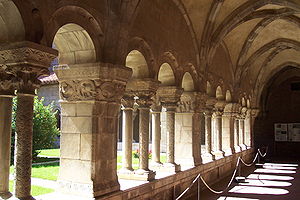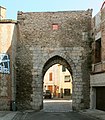Elne
|
Elne Elna |
||
|---|---|---|

|
|
|
| region | Occitania | |
| Department | Pyrénées-Orientales | |
| Arrondissement | Ceret | |
| Canton | La Plaine d'Illibéris (main town) | |
| Community association | Albères, Côte Vermeille et l'Illibéris | |
| Coordinates | 42 ° 36 ′ N , 2 ° 58 ′ E | |
| height | 0-65 m | |
| surface | 21.29 km 2 | |
| Residents | 8,941 (January 1, 2017) | |
| Population density | 420 inhabitants / km 2 | |
| Post Code | 66200 | |
| INSEE code | 66065 | |
| Website | http://www.ville-elne.fr/ | |
 Cloister by Elne |
||
Elne ( Elna in Catalan ) is a French city in the Pyrénées-Orientales department of the Occitania region . The city's 8941 inhabitants (as of January 1, 2017) call themselves Illibériens.
geography
Elne is located on the Tech , twelve kilometers south of Perpignan , seven kilometers north of Argelès-sur-Mer , six kilometers from the Mediterranean in the hinterland of Saint-Cyprien , in the vicinity of the towns of Palau-del-Vidre , Latour-Bas-Elne , Alénya , Corneilla-del-Vercol , Montescot , Bages and Ortaffa and is surrounded by apricot and peach plantations.
history
The hill of Elne, on the top of which the former episcopal monastery is located today, and its surrounding landscape have been inhabited since the Neolithic , according to archaeological research . As the oldest settlement in Roussillon , it dominated the plain and the connecting route between the lower Languedoc (French: Basse Languedoc) and Catalonia . It was close enough to the coast to control the sea route, yet far enough inland to be safe from surprise attacks from the sea. Many peoples left their traces here when they crossed the Pyrenees to or from the Iberian Peninsula. The city "Illiberi" was already known by many ancient writers in the 6th century BC. Mentioned as inhabited. The place name has Iberian origins and means "new city" (Basque iri + berri ). It is doubtful whether the city (polis) "Pyrene" mentioned by Herodotus (2,33) in the 5th century BC can be identified with Elne.
According to Titus Livius (21:24), Hannibal suggested in 218 BC. BC near the city of "Illiberis" in connection with his negotiations for a free passage.
In the 1st century BC The until then apparently stately “Illiberis” suffered from competition from the mature, ancient city “Ruscino” (namesake of Roussillon), which lay between today's Perpignan and the Mediterranean Sea , and was “nothing more than a modest remnant of a once large city ".
In the 4th century AD, it had regained its splendor. This is due, among other things, to the promotion of Emperor Constantine , who gave the city the name of his mother, St. Helena had transferred, which was then called "Helena" or "Castrum Helenae", which indicates a fortified place. Within the walls of this city, Helena's grandson Constans was murdered in 350 by warriors in the service of the usurper Magnentius .
After the fall of the Roman Empire in the 5th century and the Frankish invasion (after 507, Battle of Vouillé ), Elne became one of the last bastions of the Visigoths in the 6th century and the seat of a diocese , which it remained until 1602. When the Moors crossed the Pyrenees in 719 , Elne was one of the first cities to attack. Elne also suffered greatly from the repeated attempts at liberation by Pippin the Short . The restoration of security by the Franks and Charlemagne was all the more welcomed.
When the Counts of Roussillon gained independence, Perpignan became the capital of their empire and Elne remained the seat of the bishop.
When the cathedral was consecrated in 1069, it replaced an older church. The canons completed the cloister between the 12th and 14th centuries . In 1285, under the rule of the Counts of Barcelona , the city was sacked, the cathedral set on fire and the people who had found refuge outside were massacred by the French troops of Philip the Bold .
In 1472 the inhabitants of Elne revolted against French rule. The city was defeated again, conquered and its captain, Bernat d'Oms, beheaded in 1474 . In 1493 Elne returned to the Catalan-Aragonese Kingdom together with the whole of Roussillon .
After 200 years of constant change, the bishopric came to Perpignan in 1602. In 1641 Elne suffered another victory by the French and in 1659 came under the rule of Louis XIV in the Peace of the Pyrenees . Since then Elne has been transformed into an agricultural town, which despite its repeated destruction by its various invaders remains a testimony to its past greatness.
A sculptor and a painter left their lasting impressions in the 20th century: Aristide Maillol and Étienne Terrus . La Pomone by Maillol serves as a war memorial. The studio of Terrus, in which Henri Matisse and André Derain were guests, gave birth to the Fauvism movement .
Attractions
- the former cathedral, today the parish church of Ste-Eulalie-et-Ste-Julie d'Elne from the middle of the 11th century, which was rebuilt in the 14th and 15th centuries, provided with a tower around 1404/15 and on the south side at six Side chapels was added.
- the cloister from the 12th to 14th centuries with exceptionally beautiful Romanesque sculptures
- the remains of the city wall of the upper town from the 13th and 14th centuries
- the Musée d'Archéologie , in the east wing of the cloister, with a collection of Attic ceramics from the 4th century BC And pottery exhibits from the 15th, 16th and 17th centuries
- the Musée d'Histoire , in the west wing of the cloister, with exhibits on the city's history, such as documents, seals and sculptures
- the Musée Terrus with works by Étienne Terrus and his contemporaries. However, in 2018 it became known that 82 of the 140 pictures exhibited were forgeries. The future of the museum is unknown.
- the Maternité suisse d'Elne in the Château d'En Bardou (with museum), where around 600 refugee children from the Spanish Civil War and the Second World War were born between 1939 and 1944 .
War memorial by Aristide Maillol
Town twinning
The twin town of Elne has been Castelló d'Empúries in the Spanish autonomous community of Catalonia since 1990 .
Personalities
- Elisabeth Eidenbenz (1913–2011), refugee supervisor, founder and director of the Maternité suisse d'Elne and later honorary citizen of Elne, Righteous Among the Nations
sons and daughters of the town
- Paul Barrère (1905–1978), rugby player in Toulon, Bayonne and Lourdes
- Camille Cabana (* 1930), Senator from Paris, President of the Institut du monde arabe from 1995 to 2002
- Étienne Terrus (1857–1922), painter
Individual evidence
- ^ Otto Seeck , Johann Baptist Keune : Helena 1 . In: Paulys Realencyclopadie der classischen Antiquity Science (RE). Volume VII, 2, Stuttgart 1912, Col. 2820 (with a detailed supplement that evaluates the literary sources). Doubts about the quality of the sources for this renaming are expressed in the French Wikipédia . Whether the current name of the city is derived from "(Castrum) Helenae", as Johann Baptist Keune thinks, or from the older "Illiberis" is discussed, cf. Catalan viquipèdia .
- ^ Most of the pictures in Terrus-Museum forged
- ↑ Paul Barrere , en.espn.co.uk








